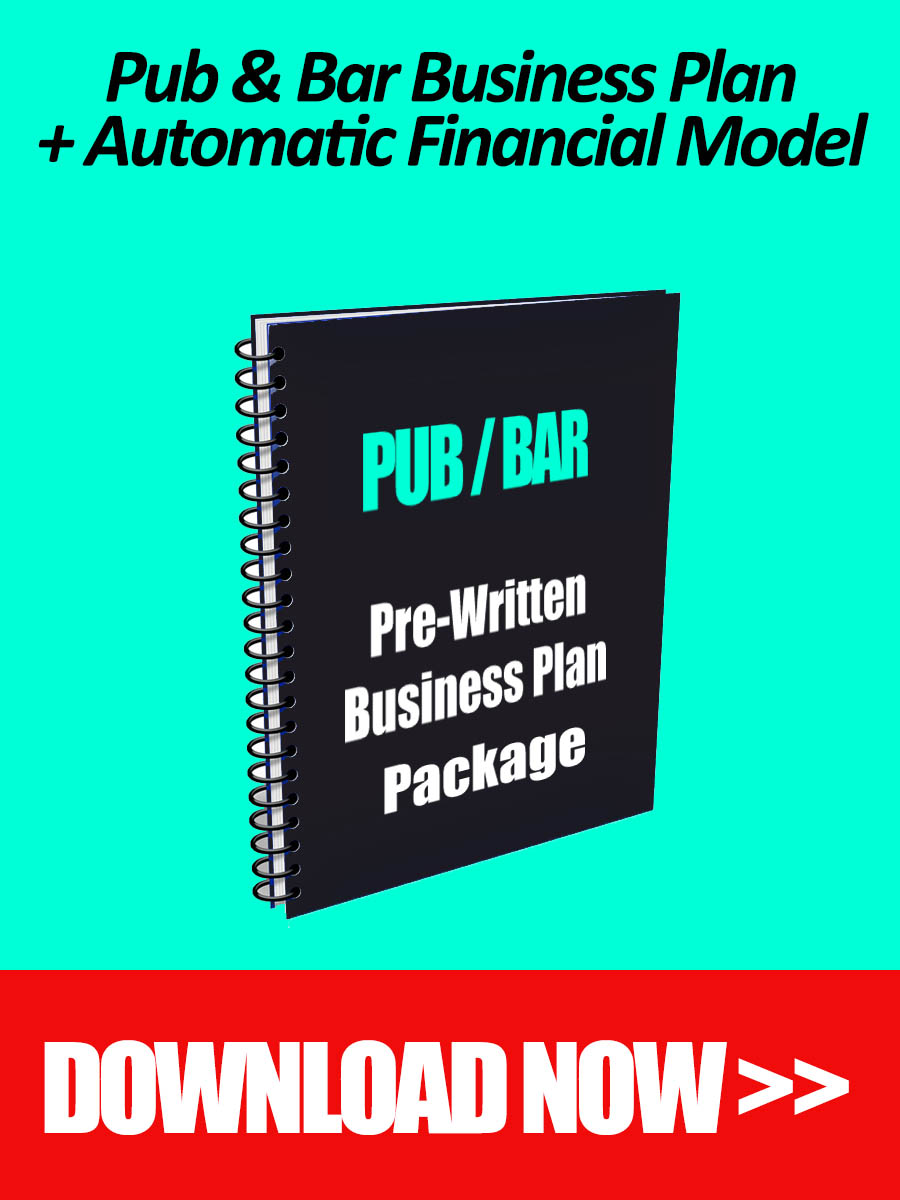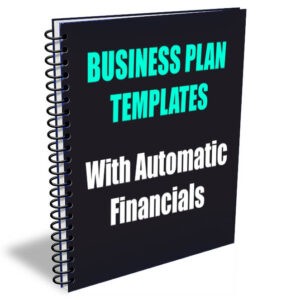Before you open a new pub, you must create a business plan. Getting funding from investors is next to impossible if your business plan is not compelling. However, that’s not the only reason why need a detailed pub business plan. Even if yours is a self-funded project, a business plan can serve as a reliable execution roadmap.
Crafting a professional pub business plan may look like a daunting task, but that’s not actually the case. Of course, you need to allot some time and conduct research to create a solid plan, but it is something that every entrepreneur can do, regardless of whether they have previously created a business plan or not. And obviously, you can count on our help, which will make things so much easier for you.
Before we get started, you might be interested to check out our Ready-made Pub Business Plan Template with pre-written text and automatic financials which you can easily customize and adapt to your own project, no financial expertise required.
In this post, we’ll walk you through all the key parts of a winning pub business plan, from crafting an impressive executing summary to creating a solid marketing plan.
Let’s dive right in.
How Many Sections A Professional Pub Business Plan Should Have?
While there’s no set-in-stone guideline, most experts agree that a good pub business plan mainly consists of the following sections:
Executive Summary
Company Overview
Customer Analysis
Competitive Analysis
Marketing Plan
Operation Plan
Management Plan
Financial Plan
So what actually goes into each of these sections? Let’s find out…
Pub Business Plan Step-by-Step Breakdown
Executive Summary
Each business plan must start with a well-written executive summary. All the same, it’s best to tackle this introductory section at the end.
Why? Glad you asked.
You see, an executive summary is considered as a compelling introduction and should summarize the key ideas of the other sections. Only then you stand a real chance to convince readers that your business plan will be worth their while. Once you have penned the other sections, it becomes easier to identify the key elements of each chapter and create an engaging summary.
Here are some tips to help you write a good executive summary:
Use a strong hook: Pique readers’ interest by showing how your business is relevant
Focus on the core strengths: Maybe your pub’s ambience is your strongest selling point or perhaps your selection of liquor and your diverse menu are unique or maybe your management team is one of the most qualified. Whatever your core strengths are, don’t forget to highlight them here.
Make only those claims that you can backup with facts: Don’t make claims for which you don’t have proof or have inadequate proof. A good executive summary is a credible one.
Here’s a sample Executive Summary for a pub business plan:
Business Name – The Single’s Bar
The Single’s Bar is a unique local bar house that aims to provide a warm and friendly space where singles can meet and mingle. The Single’s Bar is unlike your typical bar in the sense that it has a one-of-its-kind service named “thee structured conversation system”. Thanks to this service, singles can easily meet other singles and get to know them through meaningful conversation.
The bar offers a relaxed atmosphere that reduces inhibitions and inspires confidence. Research shows meeting likeminded people is not easy for singles aged between 25 and 45 years old. The Single’s Bar offers this group a great solution to the listed problem.
Conventional bars are hardly suitable for meaningful conversations since beyond the visual image of people sitting next to you, it is difficult to learn much about them and find commonalities, if any. Low lights and loud music that one finds in most bars are detrimental to having fruitful conversations.
The Single’s Bar is going to create a unique pub setting using a specific conversation structure: Singles will sit down at specific tables and talk about the highlighted topic of conversation, the aim of which is to gain insight into the other person, their perspectives and values.
Research shows the structured conversation system is highly successful as it significantly lowers uncertainty and ambiguity in the social scene. This in turn allows people to feel more comfortable which encourages them to have more meaningful conversations.
The Single’s Bar is expected to reach profitability by year three and earn substantial profits by year four.
The Single’s Bar founders, Margaret Fisher and Tony Fisher, have more than a decade’s experience in running a pub.
While there are two other bars in a mile radius, they are your traditional pubs, whereas The Single’s Bar will cater only to singles who want to meet other singles.
We need $200,000 to finance our lease costs, equipment, furniture, and renovations. Margaret and Tony Fisher will invest $50,000 in the business and the rest we plan to raise from an investor.
Company Overview
This is the section where you want to talk about your company and its finer details. To be specific, you should answer these pertinent questions here:
Who are the owners of the pub?
What is your niche?
What kinds of alcoholic drinks will you sell? What will be your menu?
How many people will you hire to run your pub business?
Here’s a sample Company Overview
The Single’s Bars (mention your business’s location) is a unique local pub that provides a great meeting place for singles. Our bar aims to bring singles together by creating an environment allowing them to meet each other comfortably.
The Single’s Bar will sell the following:
Draft beer and in bottles: We serve alcohol for two main reasons. First, alcohol helps reduce inhibition, which in turn makes it easier for people to meet new people and interact with them in a relaxed manner. Second, draft beer helps generate good profits.
Cocktails and Spirits: We will also offer a wide variety of spirits including vodka, tequila, gin and other liquors. Our bartender will also prepare a panoply of cocktails to satisfy our customer’s needs and preferences.
Wines: Some customers prefer to drink wine and hence we will offer a good variety of red and white wines, perfect accompaniments for our tapas.
Coffee and Tea drinks: A cup of well-brewed coffee or tea is often linked with a good conversation.
An assortment of Tapas: We have added tapas in our menu because they are easy to make, taste great and customers just love them. Plus, tapas are a perfect fit for tables designed for multiple people sharing food.
Our bar’s unique value proposition is based on a conversation approach allowing singles to meet new people. Hence, in addition to a section for general customers, our pub features another larger section specifically dedicated for singles to come and meet new people.
In the singles section, we will have 5 tables. The topic of the conversation will be marked at the center of each table. We will have different types of topics each evening, some will be related to news, sports, music, and movies, while others will be more philosophical and intellectual.
The Single’s Bar Founders, Margaret and Tony Fisher, will be involved in the bar’s day to day management and operation. They will initially hire 8 staff members to help them run the pub smoothly.
Customer Analysis
Talk about your target audience in this section. Try to be as specific as you can. Here’s a sample customer analysis:
Customer Analysis Sample:
The Single’s Bar targets two different groups of customers: Single people and non-singles. Both of these groups are middle to upper class
The demographics of our target audiences — both singles and non-singles — are as follows:
Working Professionals: Since the underlying promise of The Single’s Bar is “meaningful conversations”, the majority of our customers are expected to be educated and working professionals who appreciate thought-provoking, meaningful conversations.
Annual income of more than $50,000: To a large extent, this is in correlation with the fact that our audience is mainly working professionals.
Age bracket is 25-45: The biggest group of singles that are looking for companionship are between 25 and 45 years old.
Competitive Analysis
In this section introduce your direct and indirect competitors. Also, talk about how your establishment stands out.
Here’s a sample competitive analysis:
The competition to The Single’s Bar comes from various sources:
Local Bars: The area where we are located has several bars. Some bars are more suited for meeting people than others, but none of them aim to bring singles together as we do.
Coffee shops: While coffee shops offer a convenient social setting where people can meet and mingle, they rarely organize any special activities with the aim to help singles meet other singles.
It is a good idea to list your main competitors in a table and cite their key strengths and weaknesses.
Our competitive advantage: Our direct competitors (local bars) and indirect ones (coffee shops) do not explicitly organize events that encourage singles to meet. Our pub has a competitive edge on this front since we have thoughtfully designed special activities that make it easier for like-minded singles to meet each other, and have meaningful conversations.
Marketing Plan
This is the section where you highlight your go to market strategy as well as show how you plan to win new customers and retain them.
Marketing & Promotion Strategy
The Single’s Bar will target people who live and work in its 10-mile radius. Our marketing and promotional strategy includes:
Direct Mail
The Single’s Bar will distribute flyers in the neighborhoods located in its vicinity. These flyers will offer not only general information about our bar’s concept but also special discounts and coupons.
Online Marketing
The Single’s Bar will come up with a sleek and user-friendly website that allows online bookings and live chat. We will also leverage the power of social media channels to spread the word about our new bar’s concept and engage with potential customers. From time to time we may run paid ad campaigns on social media to attract new customers and showcase the atmosphere in our venue.
Pre-opening Events
Before opening the pub, we are going to organize several pre-opening events that will help create buzz and attract prospective customers.
Operating Plan
In this section you should look to provide answers to these questions:
How will you run the bar?
What will be the bar timings?
What will be your rates?
How will you source your drinks, food products and ingredients?
Preparing a detailed operating plan can help you identify issues beforehand and resolve them. For example, if you expect your bar to be jam-packed during weekends, will your staff be able to handle the high traffic on its own or will you require some additional part-time employees?
Management Plan
In this section, you need to share the names of your core team, describe their relevant work experience and past achievements. This section is usually followed by your hiring plan which can be a table summarizing the key positions you plan to hire, with their expected salaries.
Financial Plan
In the last section of your pub business plan, talk about the “finance” side of things. Specifically speaking, share information about the following:
Operating costs
Direct costs
Loan repayments
Cash flows
Expected revenues and profits
Balance sheet
Capital expenditures
Final Words
Now that you have seen what goes into a powerful pub business plan, it’s time to roll your sleeves and begin the business planning process. You can start by downloading our FREE business plan template to get you started. Otherwise, we also recommend you check out our Ready-Made Pub Business Plan with automatic financials. We guarantee it will save you tons of time and money.
Whatever method you choose, we wish you good luck!



